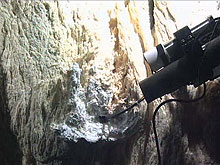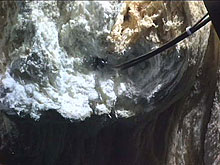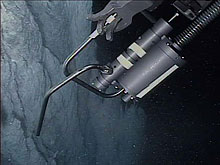Water sampling is a critical process to understanding the reactions
taking place at Lost City. Watch to see how we collect the fluids
over 2000 feet below sea level. ![]() Click
image to view video and
video credit.
Click
image to view video and
video credit.
Water Sampling
July 28, 2005
Dr. David Butterfield
Chemical Oceanographer
JISAO Program
University of Washington
NOAA Vents Program
Dr. Gretchen Fruh-Green
Senior Research Scientist
Department of Earth Sciences
ETH-Zurich, Switzerland
Dr. Marvin Lilley
Professor
University of Washington
School of Oceanography
![]() Water
sampling is a critical process to understanding the reactions taking
place at Lost City. (Quicktime,
1.7 Mb)
Water
sampling is a critical process to understanding the reactions taking
place at Lost City. (Quicktime,
1.7 Mb)
An important goal of our expedition is to better understand how the reactions of the basement rocks influence the chemistry of the fluids and hydrothermal chimney growth. Secondly, how do these fluids provide nutrients for biological communities in and around the vent structures? Unlike black smoker hydrothermal systems, the rocks underneath Lost City originate from the Earth's mantle and have been transported from great depths - typically greater than about 6 kilometers below the seafloor. Large faults have exposed these mantle rocks on the seafloor, and when seawater reacts with them, new minerals - in particular the mineral serpentine - are formed, and heat is produced. This process, referred to as serpentinization, is an important reaction occurring where mantle rocks are exposed near the seafloor and is what drives the Lost City hydrothermal system. Another consequence of serpentinization is that it raises the pH of the hydrothermal fluids to very basic values of pH 10-11 and results in high concentrations of hydrogen and methane, which are important sources of energy for microbial life. These heated, high pH fluids rise to the seafloor and produce the carbonate chimneys when they mix with seawater.
This expedition gives us an exciting opportunity to take samples of the hydrothermal fluids, the rocks, and the biology at the same locality. Analyses of the chemical and isotopic compositions of water samples from the different venting structures will help us answer some important questions, such as:
- What is the chemical composition of the purest hydrothermal fluid?
- How hot are these fluids and what reactions are determining their chemical composition?
- How do these fluids lead to chimney growth and how long has this area been actively venting?
- Which chemical compounds do the organisms at Lost City use as their energy sources and what is the source of these compounds?
The major sampler is a titanium sampler used to collect hydrothermal fluids. Similar to a syringe, a trigger on the outside of the bottle can be pressed by the ROV pilot to release a spring that will draw fluid into the chamber. Approximately 750ml of fluid can be collected using the Major bottles. On deck, this volume is split into separate containers for various analyses including major and trace elements, nutrients, and various isotopes. Alkalinity, pH, and silica are measured at sea. Click image for larger view and image credit.
To collect these water samples, we are using three types of water samplers. One is the so-called "major sampler", a titanium syringe that has long been used to sample hydrothermal fluids in black smoker environments. These samplers are ideal for collecting dissolved ionic constituents but are designed to release pressure as the vehicle rises and in so doing, release much of the dissolved gas. The other two samplers are designed to collect samples that can be returned to the surface without losing any of the gas contents. Volatiles (gases) are an important component of hydrothermal fluids so we are using all three samplers to be sure we get the best samples for everyone involved in trying to understand this system.

An IGT Sampler (Isobaric Gas Tight sampler) is used to extract venting fluid from an actively venting site. This tool is used for two purposes during this expedition. This IGT is fitted with a temperature probe, which is hard-wired to Hercules so that scientists on board the Brown can read the temperatures the IGT is measuring while the IGT is bathed in vent fluid. The second purpose of the IGT is to collect a vent fluid sample in a chamber that is both sealed off to gas exchange and is held at constant temperature. Vent fluid from the gas tight samplers (both the IGT and the regular GT samplers) is analyzed for dissolved gases such as hydrogen, methane, and carbon dioxide. Click image for larger view and image credit.

The gas tights are custom-designed titanium tools used to collect vent fluid samples inside a chamber that is sealed off to gas exchange. Fluid samples from the gas tight samplers are analyzed for dissolved gases, such as hydrogen, methane, and carbon dioxide. The sampling device operates like a syringe, where the ROV pilot triggers a release on the bottle to draw in sample. All fluid sampling devices are fit with "T-handles" so that the manipulator arm claw can easily clench them. Click image for larger view and image credit.
When we collect the samples, we look for the most active venting site. This helps us collect the purest hydrothermal fluid without mixing in a lot of seawater when we trigger the samplers. It definitely is a challenge for the Hercules pilots to find the best spot, hold the ROV stable and insert the sampler snorkel into just the right spot to collect the best sample.
Sign up for the Ocean Explorer E-mail Update List.




























